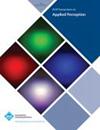Motor Variability in Complex Gesture Learning: Effects of Movement Sonification and Musical Background
IF 1.9
4区 计算机科学
Q3 COMPUTER SCIENCE, SOFTWARE ENGINEERING
引用次数: 4
Abstract
With the increasing interest in movement sonification and expressive gesture-based interaction, it is important to understand which factors contribute to movement learning and how. We explore the effects of movement sonification and users’ musical background on motor variability in complex gesture learning. We contribute an empirical study in which musicians and non-musicians learn two gesture sequences over three days, with and without movement sonification. Results show the interlaced interaction effects of these factors and how they unfold in the three-day learning process. For gesture 1, which is fast and dynamic with a direct “action-sound” sonification, movement sonification induces higher variability for both musicians and non-musicians on day 1. While musicians reduce this variability to a similar level as no auditory feedback condition on day 2 and day 3, non-musicians remain to have significantly higher variability. Across three days, musicians also have significantly lower variability than non-musicians. For gesture 2, which is slow and smooth with an “action-music” metaphor, there are virtually no effects. Based on these findings, we recommend future studies to take into account participants’ musical background, consider longitudinal study to examine these effects on complex gestures, and use awareness when interpreting the results given a specific design of gesture and sound.复杂手势学习中的运动变异性:运动声化和音乐背景的影响
随着人们对运动声音化和基于表达手势的交互的兴趣日益浓厚,了解哪些因素有助于运动学习以及如何促进运动学习是很重要的。我们探讨了动作声音和使用者的音乐背景对复杂手势学习中运动变异性的影响。我们贡献了一项实证研究,其中音乐家和非音乐家在三天内学习两个手势序列,有和没有运动超声。结果显示了这些因素相互交织的影响,以及它们如何在三天的学习过程中展开。对于手势1来说,它是快速和动态的,具有直接的“动作声音”声,动作声在第一天对音乐家和非音乐家都产生了更高的变异性。虽然音乐家在第2天和第3天将这种可变性降低到与没有听觉反馈条件相似的水平,但非音乐家仍然具有明显更高的可变性。在三天的时间里,音乐家的变异性也明显低于非音乐家。而动作2则缓慢而流畅,带有“动作音乐”的隐喻,几乎没有效果。基于这些发现,我们建议未来的研究考虑参与者的音乐背景,考虑纵向研究来检验这些对复杂手势的影响,并在解释给定特定手势和声音设计的结果时使用意识。
本文章由计算机程序翻译,如有差异,请以英文原文为准。
求助全文
约1分钟内获得全文
求助全文
来源期刊

ACM Transactions on Applied Perception
工程技术-计算机:软件工程
CiteScore
3.70
自引率
0.00%
发文量
22
审稿时长
12 months
期刊介绍:
ACM Transactions on Applied Perception (TAP) aims to strengthen the synergy between computer science and psychology/perception by publishing top quality papers that help to unify research in these fields.
The journal publishes inter-disciplinary research of significant and lasting value in any topic area that spans both Computer Science and Perceptual Psychology. All papers must incorporate both perceptual and computer science components.
 求助内容:
求助内容: 应助结果提醒方式:
应助结果提醒方式:


